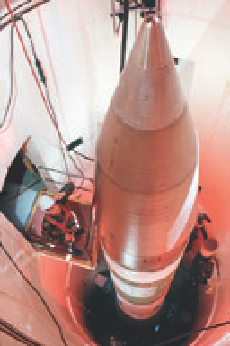Information Technology Reference
In-Depth Information
more than fifty IC companies in and around San Jose, California. Noyce and
Moore were the last of the founders to leave Fairchild. In 1968, they set up a
new company with the intention of specializing in memory chips. The name
of their new company was Intel Corporation, short for
int
egrated
el
ectronics.
At that time, the best random access memory (RAM) chip had a capacity of
sixty-four bits, which was not sufficient to supplant magnetic core memory in
computers. RAM refers to data storage that allows information to be accessed
in any order, unlike storage on a magnetic tape, which can only access infor-
mation in a linear fashion by moving along the tape. By storing frequently used
or active files in RAM, the computer can access the data much faster from RAM
than it can retrieve information from a hard disk - and very much faster and
much more flexibly than from magnetic tape.
In 1968, Bob Dennard (
B.7.8
) from IBM patented a one-transistor design
for
dynamic
RAM, or DRAM. In his design, a single bit of information can be
stored in a memory cell consisting of one transistor and a tiny capacitor. This
innovation simplified the design of memory chips and permitted a significant
increase in memory capacity. Dynamic memory is so-called because the stored
charge leaks slowly away and the memory cell needs to be regularly refreshed
to maintain its contents. It is possible to design
static
RAM (SRAM) chips that do
not need refreshing but this type of RAM needs more transistors to implement
and is therefore more expensive. In 1970, Fairchild, now a competitor to Moore
and Noyce's new company, brought out a 256-bit DRAM memory chip. This
chip received much momentum by being chosen as the memory for an ambi-
tious “parallel computer,” the Illiac-IV, under construction at the University of
Illinois. A parallel computer has many processing units and a programmer has
to orchestrate the work of all of these units to solve a problem. Although the
Illiac-IV computer had only limited success - parallel programming is still too
hard - the project showed that semiconductor memory was a viable alternative
to magnetic cores. By the end of 1970, Intel had responded to Fairchild's 256-bit
chip by introducing the 1103, the first 1,024-bit DRAM chip, using a three-tran-
sistor design. In 1971 Intel's revenues were about $9 million; three years later
these had almost tripled. The end of magnetic core memories was in sight.
Fig. 7.12. Minuteman missile silo, South
Dakota, United States.
The microprocessor and Moore's law
The first electronic calculator was called the ANITA and was produced
in 1961 by the Bell Punch Company in the United Kingdom. It used discrete
transistors and was about the size of a typewriter. Later in the 1960s, Texas
Instruments built a calculator using ICs. Some were logic circuits for doing
the calculations, others were RAM, and still other circuits provided
read-only
memory
(ROM) for the operating system and subroutine libraries. The contents
of ROM can be accessed and read but cannot be changed. When cheap pocket
versions appeared in the 1970s, the traditional slide rule of the engineer rap-
idly disappeared. At the beginning of NASA's Apollo space program in 1963,
the guidance computer of the lunar module was constructed from about five
thousand logic chips. On the last Apollo mission in 1975, one astronaut carried
a Hewlett Packard HP-65 pocket calculator more powerful than the spacecraft's
guidance computer.
Fig. 7.13. Photograph of the Minuteman
I missile guidance computer assembled
from discrete electronic components:
transistors (1,521), diodes (6,282), resis-
tors (504), and capacitors (1,116). The
computer was specially designed to sur-
vive and function in extreme conditions.
In the Minuteman II, ICs manufactured
by Texas Instruments replaced multiple
transistor boards. The Minuteman II
computer used about two thousand ICs.


Search WWH ::

Custom Search